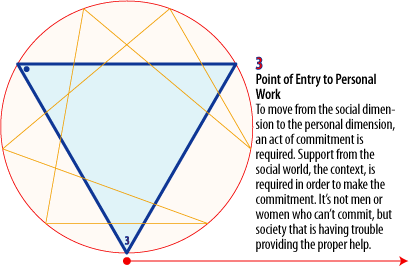Point 3: Commitment, the first “corner”
It's neither men nor women who are having trouble committing to relationships — society is struggling to provide the kind of help that is required.
Point 3: Commitment, the first “corner”
Each point where the triangle touches the circle of time represents an opening into another dimension. It’s a stage when new possibilities are opened and others are closed – the universe conserves potential energy as well as momentum. When the circular flow of events touches the triangle of the creative future, there’s a “corner,” or “interval” in the Gurdjieffian/Ouspenskian terminology. In the process of personal relationship, the first “corner” is the point of commitment.
The events of meeting and falling in love are, like all the other events around the circle of the Enneagram, key stages in the process of relating. But the disproportionate attention paid to point 2 in the popular literature on relationship obscures the fact that, as passionate and dramatic as point 2 is, it is not the “be all and end all,” the fulfillment, the completion of a loving relationship. The partners can’t fall in love forever. Sooner or later they have to fall to earth, touch down, and move forward in their journey. If not, they fall apart, fall out of love and stop “seeing” each other. At point 2 of their process, new lovers may be blinded by bliss at times, but they also have a serious case of double vision. The inner “chef” sees point 8, the potential for union, and also point 4, where personal differences come to the fore. We find lots of descriptions in literature about the emotional turbulence that results as two people who have fallen in love find their experience shifting between visions of eternal bliss (2 – 8) and fears of unresolvable conflict (2 – 4).
What is beyond “seeing?” Touching, holding, supporting. Being part of a committed relationship means undertaking a journey together, working together to make the vision real, to overcome the obstacles, to fulfill the premise of the relationship in fact and to make the feeling of unity a reality. For the relationship to continue past the point of falling in love, there must be a transition from “turning toward” each other to “turning to” each other. Committed partners turn to each other for material and emotional support. We can also think of the middle stage of the process as one that requires of us that we “turn to” in the sense of committing to the work of deepening and strengthening the bond that began to form as we recognized each other and fell in love.
Keep reading with a 7-day free trial
Subscribe to Turning Into Each Other to keep reading this post and get 7 days of free access to the full post archives.



